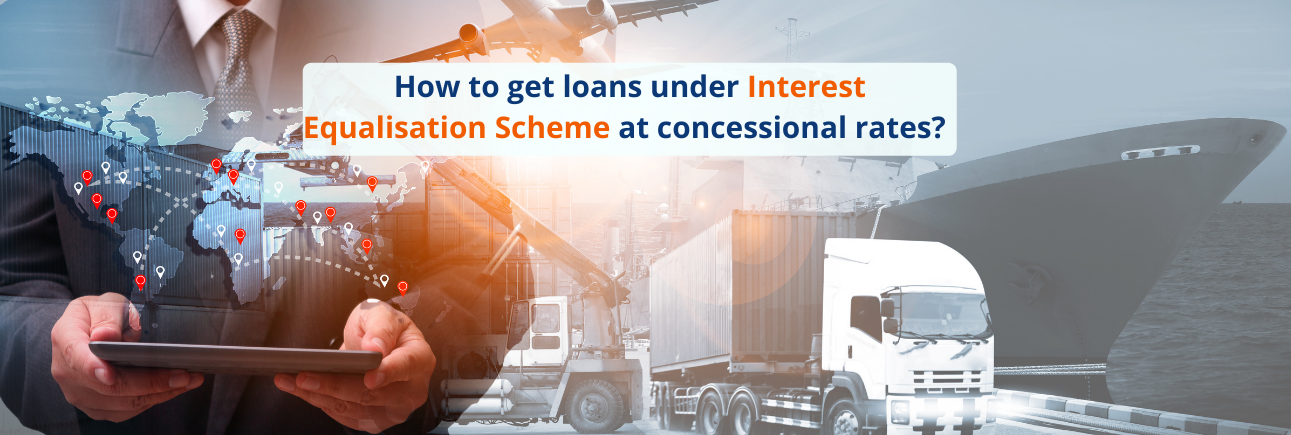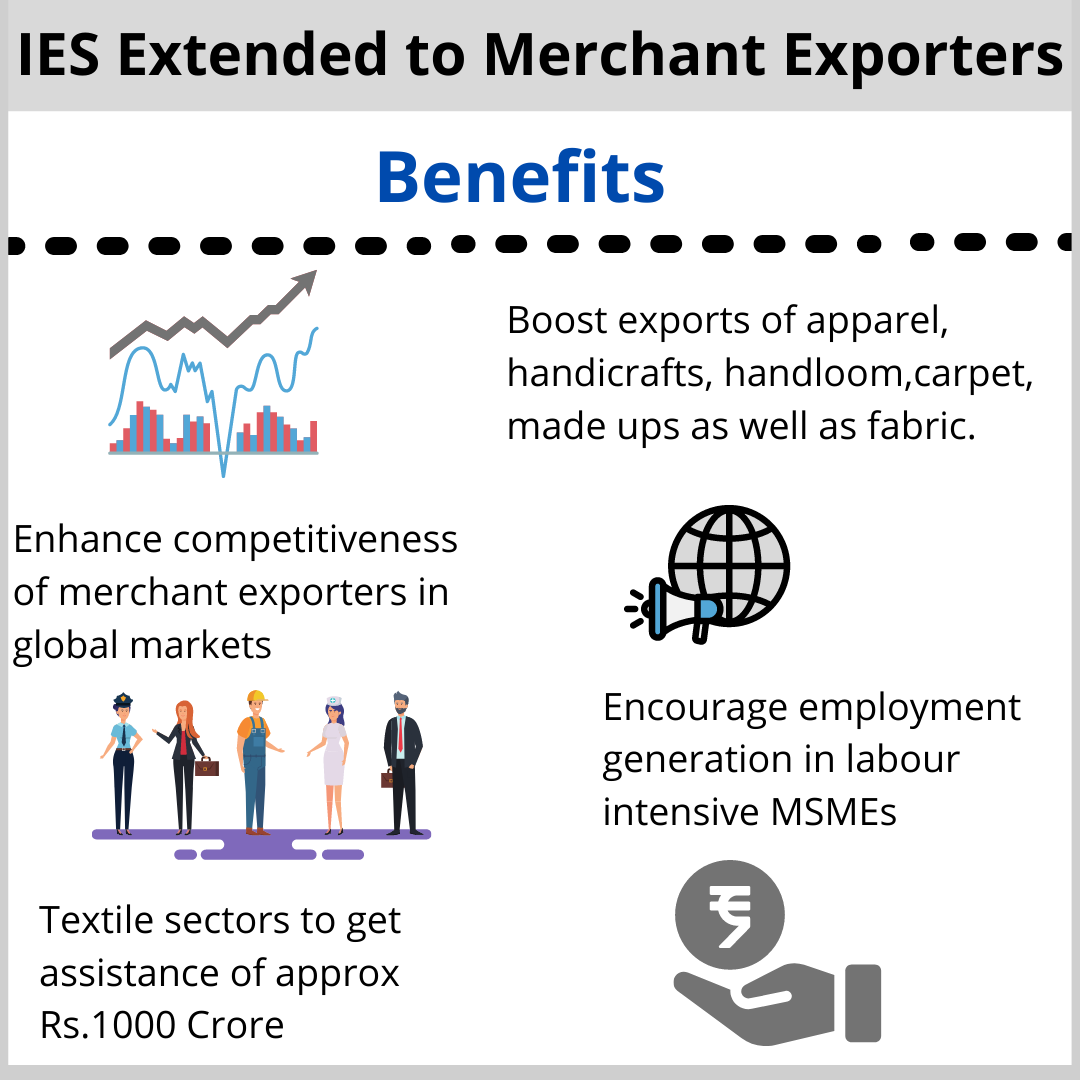

What is an Interest Equalisation Scheme?
The interest equalisation scheme (IES) has emerged as a privilege for MSMEs exporters since the commerce ministry established on 1st April 2015.
With the implementation of this scheme, the government expects that the exporter shall correct their pricing and improve the competitiveness of their products.
The IES scheme, also known as the interest subvention export scheme which was specially designed for exports of the MSME segment.
Note: As part of the relief measures declared during the covid-19 lockdown period, the government has extended the interest equalisation scheme for the interest rate on pre & post-shipment rupee export credit facility.
With the help of this scheme, now exporters can get access to reduced costs of capital.
Based on industry reports, revealed that the scheme has provided some kind of relaxation to a huge number of SME exporters who were affected by the covid-19 pandemic.
The rising level of covid persuades sorrow for the exporting sector. Commerce Ministry has earlier stated that the Government of India has budgeted Rs. 19,00 crores for the scheme of financial year 2022 against Rs.1,600 crore (revised estimate) for the financial year 2021.
On the 8th of march, the reverse bank of India extended the IES for the pre-and post-shipment rupee credit for micro small medium enterprises (MSMEs) exporters till March 2024.
A recent RBI notification declared that RBI has also revised its rates for the interest equalisation scheme.
The revised interest rates under the scheme will begin at 3% for MSME manufacturers and exporters transporting under any HS lines and 2% for manufacturers and merchant exporters exporting under 410 HS lines.
Labor-intensive and employment-generating sectors are covered under the interest equalisation scheme. Moreover, among the top foreign exchange earners covered under the scheme are as follows:
-Processed agriculture/food items
-Handicrafts, handmade carpet and handloom products
-Manufacturers of coir based including yarn and other jute
-Readymade garments
-Fabrics of all types
-Toys, sports goods, paper and stationery
- Business engaged in cosmetics and toiletries, leather footwear and goods
- Ceramics and its allied products sectors
-Medical and scientific instruments, optical frames, lenses, sunglasses
-Auto components, bicycles and parts thereof
To avail loan under this scheme, borrowers need to meet the eligibility criteria set by the commerce ministry for manufacturing firms and merchant exporters as given below:
An Interest equalisation scheme is offered to all MSME exporters. Under this scheme, interest relief is provided on the outstanding loans/balance at 2% per annum from the date of disbursement of the loan.
Interest subvention of 2% is given to the MSMEs on the fresh/incremental amount of working capital sanctioned or new/incremental term loan that shall be disbursed by the eligible lending institutions.
Typically, 2 percent of interest subvention is given to micro small-medium enterprises on the fresh/incremental working capital sanction or term loan that shall be disbursed by the eligible lending g institution.

Merchant exporters play an important role in export growth and in facilitating export by MSME manufacturers.
Merchant exporters are considered to be important role players in export development and in facilitating export by manufacturers. The interest subvention scheme is aimed at providing easy financing at a concessional rate.
Vinay Thadani, CFO of Vishal Fabrics Ltd, stated that in order to qualify as “originating from India", the borrowers must fulfill the eligibility requirements, the goods exported should meet the requirements of minimum processing.
These are written in the Rules of Origin of the Handbook of Procedures of the Foreign Trade Policy (FTP) 2015-20.
According to the rules:
In addition, also said that goods must be manufactured by the exporter according to the definition of manufacture of FTP.
Also, if the use of imported inputs; the export products shall be classified as originating in India only if they undergo significant operations.
However, the benefit of interest equalisation will be available from the date of disbursement up to the date of repayment or up to the date before which that outstanding export credit becomes overdue.
Most prominently, the interest equalisation scheme will be available only to the eligible exporter that too in the course of the scheme is in force.
If the goods are manufactured by MSMEs and SMEs following are the products that are considered to be eligible:
To claim these benefits, an eligible exporter needs to submit a certification of the external auditor to the concerned bank.
On behalf of the borrower, the bank provides benefits to the exporters and claims reimbursement through the Reverse Bank of India based on the external auditor’s certification issued by the exporter, adds Thadani.
As per the scheme rules and regulations, the bank has the responsibility of deciding if a borrower is eligible, and the banks will assist them with financial support to the beneficiary’s account with the eligible amount of interest equalisation.
Thereafter, the banks concerned will reduce the interest rate charged on the eligible exporters based on the interest equalisation given by the RBI.
To ensure that exporters' applications for interest equalisation are treated favorably by the officials, the exporters are required to do proper due diligence as needed for the paperwork and follow certain good industry practices.
It is advisable for exporters to always maintain a good business track record, especially in financial terms.
Monitoring proper records and undertaking timely compliance under GST and income tax is an added advantage. Also, monitor your credit rating from time to time.
The commerce ministry has aimed to monitor the scheme effectively and decided to operationalize a new online module for filing of electronic registration for interest equalization scheme for MSMEs exporters.
Under this scheme, exporters get subsidies for pre-and post-shipment rupee export credit facilities.
Moreover, the interest rate under this scheme has been revised downwards to 2% and 3% for specified categories of manufacturer exporters as against the earlier rate of 5% and 3%.
To capture beneficiaries information of the scheme. It has been decided to implement a new online module for the interest equalisation scheme.
All exporters looking to benefit from the scheme need to apply online by visiting the DGFT website.
Thereafter, a unique IES Identification Number (UIN) will be generated instantly which shall be required to submit to the concerned bank when getting interest equalisation against their pre and post-shipment rupee export credit applications.
Usually, the generated UIN has a validity of 1 year from the date of registration in the course of which an application can be submitted with the concerned bank to avail IES benefit.
The instantly generated acknowledgment including UIN required to be submitted to the concerned bank along with the prescribed application by the bank.
All applications made on or after 1st April 2022, are necessarily submitted UIN acknowledgment with the concerned bank.
1. Merchandise Export from India Scheme:
Under the merchandise export from India scheme (MEIS), An incentive of 2 percent to 5 percent of the FOB value of exports is given to the merchant and manufacturer exports.
2. Service Export from India Scheme:
Under this type of scheme, an incentive of 3 percent to 7 percent of net foreign exchange earnings is given to services exporters of notified services in India.
To claim under the scheme, the applicant needs to have an active import-export code (IEC Code) with at least net foreign exchange earnings of $15,000 USD to be eligible and benefit from the SEIS scheme.
3. Duty exemption scheme:
i). Advance Authorisation Scheme (AAS): This allows duty-free import of raw materials required for the production of export goods.
ii). Duty-Free Import Authorisation (DFIA Scheme): This scheme allows duty-free import after the export is made.
4. Duty Remission schemes:
i) Duty Drawback (DBK) Scheme: Duties of customs & central excise that are chargeable on imported and indigenous materials used in the manufacture of exported goods are refunded back.
ii) RoSCTL Scheme: This scheme is only applicable to the apparel & made-up Industry.
5. Export Promotion Capital Goods Scheme:
A manufacturer exporter or a merchant exporter tied with a supporting manufacturer can be able to import capital goods/machinery which are required for pre-production and post-production of export goods at zero percent duty.
6. Export Oriented Scheme (EOU):
This scheme aims to provide a beneficial ecosystem to the companies in 100% exports by giving them certain waives and concessions in compliance and taxation matters.
This initiative is being taken to make the business process even more flexible.
7. Deemed Export Benefits:
Under this scheme the following benefits can be availed by deemed export benefits:
Advance Authorisation/DFIA
Deemed Export Duty Drawback
Refund of terminal excise duty
8. Star Export House / Status Holder Certificate:
Govt of India gives certification to all eligible exporters who have achieved certain export turnover.
The applicant with star export house/ status holder certificate are eligible for certain privileges like faster custom clearances, and exemption from compulsory negotiation of documents through lending institutions.
1. Gold Card Scheme:
Under this type of scheme, one can avail credit limit facility for up to 3 years, a credit limit renewal facility and an additionally 20% limit to meet any kind of sudden requirement of export on account of additional orders are provided by banks.
This can be issued by all eligible exporters including small and medium-sized enterprises who have satisfied their pre-requisite condition given by banks.
2. GST refund benefits for exporters:
Under the GST Act, exporters are provided a host of favorable facilities as given below:
LUT Bond Facility – Exporters can export goods without paying any GST by getting a letter of bond.
IGST Refund – Exporters can export goods on GST payment. Thereafter, they claim for a refund of the same with the customs department.
1% GST benefit for Merchant Exporters –
Merchant exporters can avail of goods that are meant for export from the domestic market suppliers at a concessional GST rate of 0.1 percent.
This makes the burden reduced at its maximum and solves the working capital issues for merchant exporters to a great extent.
What is Interest equalisation scheme IES?
The interest equalization scheme (IES) was aimed at providing pre-and post-shipment export credit facilities to exporters in rupees.
How can I claim interest subvention for MSMEs?
MSMEs can apply for interest subvention for outstanding term loans or working capital with eligible lending institutions.
To claim interest subvention, the applicant needs to submit duly certification by the statutory auditors of the eligible lending institution.
What is a Subvention Fee?
Subvention means grant of money by the Government of India. It is an interesting subvention; in which government pays a certain portion of the interest on business loans.
Is there any difference between subsidy and interest subvention?
The subsidy is provided by the government with the motive to boost production and consumption. Wherein, the government pays a portion of the cost of production of certain goods or services. But a subvention scheme gives a relief in the buyer’s loan interest burden.
What is pre and post-shipment rupee export credit?
Pre-Shipment finance is also known as the credit extended to the exporters before the shipment of goods for the execution of the export order while on the other hand post-shipment finance is known as the credit extended to the exporters after the shipment of goods for fulfilling working capital requirements.
Also Read: